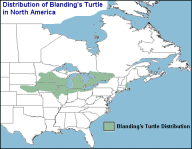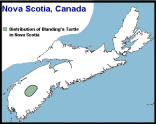Physical
Characteristics
The Blanding's turtle (Emydoidea blandingii) is one of the
longest-lived (greater than 70 years) and slowest maturing turtles (20+
years). It has a moderately high-domed carapace (top shell) spotted
or streaked with greyish-yellow. Coloration between individuals is
highly variable. In Nova Scotia, adult carapace length ranges from 18 to
25 cm. Males are typically larger than females.
 Its plastron (lower shell)
is formed from a series of scutes (plates), each of which is yellow with
irregular black spots in the outer corner. In juveniles, annual
growth rings are easily visible on each scute. Its shell is
semi-hinged, allowing the turtle to pull its head and limbs in for
defense. Colour on the top and sides of the head varies from black to
brown to olive with yellowish spots or mottling. In sharp contrast with
the rest of the turtle, the chin, throat, and underside of the long neck
are bright yellow. It appears to have a permanent "smile"
because of the notch in its upper jaw.
Its plastron (lower shell)
is formed from a series of scutes (plates), each of which is yellow with
irregular black spots in the outer corner. In juveniles, annual
growth rings are easily visible on each scute. Its shell is
semi-hinged, allowing the turtle to pull its head and limbs in for
defense. Colour on the top and sides of the head varies from black to
brown to olive with yellowish spots or mottling. In sharp contrast with
the rest of the turtle, the chin, throat, and underside of the long neck
are bright yellow. It appears to have a permanent "smile"
because of the notch in its upper jaw.
Natural History
Habitat
Although the ancestral
habitat of Blanding's turtle was likely prairie marsh, today populations
occur in both prairie and forested regions. Macro-habitats include lakes,
ponds, fens, marshes, low fields, ditches, creeks, river sloughs, and
bogs. Within these macro-habitats, Blanding's turtles tend to
frequent shallow water containing submergent or emergent vegetation, often
with deep, organic sediments.
Food
Blanding's turtle is an
aquatic predator that feeds at several levels of the food chain. Food
items include frogs (adults, tadpoles and eggs), insect larvae and nymphs
(especially dragonflies), freshwater snails, leeches, and small fish, as
well as vegetable matter (including cow lily seeds). Feeding mostly
occurs underwater and food seized on land is generally carried to the
water for swallowing. Prey is either swallowed whole or if it is too large
it is held by the jaws and shredded into smaller pieces by the front claws
(Harding 1997).
Predators
Eggs and hatchlings are
preyed upon by a variety of generalist predators including raccoons,
skunks, ravens, short-tailed shrews, and ants.
Few hatchlings (less than 1%) survive to adulthood.
Once they reach adulthood, they are largely free from predation,
with the exception of encounters with vehicles.
Reproduction
Fertilization
in Blanding's turtles is internal, with copulation taking place in the
water. Mating occurs year-round in Nova Scotia with the peak in the fall.
Nesting occurs in June and early July.
Females may travel considerable distances from the water to find
suitable nest sites to lay their eggs. In Nova Scotia they nest in a
variety of habitats including lakeshores, rocky outcrops, roadsides and
gravel roadbeds and other clearings created by humans. Although
elsewhere the species nests in sand and soil, in Nova Scotia, nesting
substrates are predominantly cobble and gravel.
Hatchlings emerge approximately 90 days later, depending on the temperature and moisture in the nest. The sex of Blanding's turtles is determined by the temperature at which they were incubated; eggs incubated at low temperatures (below 25C) produce nearly all males and those incubated at higher temperatures (above 30C) are nearly all females. The success of Blanding’s turtle nests is highly variable. Even if a nest does not get depredated, it often fails either completely or partially due to flooding, poor incubation conditions, infertile eggs and other factors.
Distribution
of the Blanding's Turtle
 Throughout its range
Blanding's turtle is patchily distributed, especially in peripheral
regions. Its fragmented range extends from extreme southwestern
Quebec and southern Ontario west to Minnesota and Nebraska and south to
central Illinois. Nebraska and Minnesota presently support the largest
populations. Isolated local populations occur at the western periphery of
the main range in Minnesota, Wisconsin, and at the eastern periphery in
New York, Maine, Massachusetts, New Hampshire, and Nova Scotia. Follow this link for a
more detailed
map of the North American distribution. [Click Images to Enlarge]
Throughout its range
Blanding's turtle is patchily distributed, especially in peripheral
regions. Its fragmented range extends from extreme southwestern
Quebec and southern Ontario west to Minnesota and Nebraska and south to
central Illinois. Nebraska and Minnesota presently support the largest
populations. Isolated local populations occur at the western periphery of
the main range in Minnesota, Wisconsin, and at the eastern periphery in
New York, Maine, Massachusetts, New Hampshire, and Nova Scotia. Follow this link for a
more detailed
map of the North American distribution. [Click Images to Enlarge]
 In Nova Scotia, the
Blanding's turtle reaches the northeastern periphery of its range and
exists only in several small separate populations in the southwestern
interior of the province. Confirmed sightings are limited to the Mersey and Medway watersheds,
with yet unconfirmed additional sightings in the LaHave, Roseway and Bear
River watersheds. We currently recognize three distinct populations in
Nova Scotia, one in Kejimkujik National Park and National Historic Site
and two in working landscapes on the Medway watershed.
In Nova Scotia, the
Blanding's turtle reaches the northeastern periphery of its range and
exists only in several small separate populations in the southwestern
interior of the province. Confirmed sightings are limited to the Mersey and Medway watersheds,
with yet unconfirmed additional sightings in the LaHave, Roseway and Bear
River watersheds. We currently recognize three distinct populations in
Nova Scotia, one in Kejimkujik National Park and National Historic Site
and two in working landscapes on the Medway watershed.
Historical Knowledge of
Distribution
Blanding's turtles were not
reported in Nova Scotia until 1953. Although nothing is known of the
history of the species in Nova Scotia, a comparison of past and present
distributions over the entire range shows that the species' distribution
has changed considerably. Fossil evidence, which occurs to the south
and west of the centre of the present distribution, suggests that the
species' range has shifted eastward since the last glaciation. This shift
may have resulted from habitat disappearance and changing climatic
conditions. Of the known disjunct populations, the Nova Scotia population
is the most isolated and is thought to have become established during a
warmer climatic period.
Nova Scotia Population of Blanding's Turtles
Blanding's
turtles in Nova Scotia exist as a population complex well isolated from
the rest of the species range. Over the past decade research
has revealed some significant differences between Blanding’s turtles in
Nova Scotia and those in the main range. In Nova Scotia:
- Nesting occurs later (June and July) and eggs have an extended incubation
- Many turtles nest on lakeshores, rather than inland
- Nesting substrates are predominantly cobble and gravel; whereas elsewhere the species nests in sand and soil
- Clutch success and recruitment into the breeding population are particularly hindered by regional environmental constraints (e.g., cooler incubation season, nest flooding) and high rates of nest and juvenile predation
- Turtles grow more slowly and mature later (20-25 years) than in many other populations
- Although the species covers a limited geographic area and exists in low numbers, the three known populations are distinct. Populations are genetically distinguishable suggesting that there is very little movement of turtles between them. Differences in behavior, habitat use, growth rates, adult size and clutch size have also been recorded among them.
- The species has significantly diverged genetically from populations in the main range and harbours a significant portion of the total genetic biodiversity of the species
Nova Scotia population:
In 2005 COSEWIC (Committee on the Status of Endangered Wildlife in Canada)
uplisted the Nova Scotia populations of the Blanding's turtle from
"Threatened" to "Endangered" based partly on a
Population Viability Analysis that indicated the KNP population was
declining. In 2000, under newly enacted endangered species legislation,
Nova Scotia declared the Blanding's turtles "Endangered".
These decisions were based, in part, on the species’ limited
distribution within the province, the population’s uneven age structure,
and the low rate of recruitment into the breeding population.
Status Elsewhere: In Canada, Blanding's turtle is protected (i.e.,
may not be collected or disturbed) in all national parks where it occurs.
In Ontario, the species has been protected since 1984 under the Game and
Fish Act. In the United
States, Blanding's turtle is protected in the states of New
York, Michigan, and Minnesota and considered threatened or endangered in
Missouri, Wisconsin, Maine, New Hampshire, Massachusetts, Iowa, and
Pennsylvania. The species has been extirpated from Rhode Island and
Connecticut. Internationally, the World Conservation Union (IUCN)
ranked the species in 1996 as "Lower risk: near-threatened".
More Information on How Status is Determined
For a more in-depth description of the Nova Scotia General Status Ranking
system, the Nova Scotia Endangered Species Act, or the federal COSEWIC
ranking system please visit the following sites.
General
Status of Wild Species of Nova Scotia
Nova Scotia Endangered Species Act
The Nova Scotia Endangered Species legislation as a document on the legislature's web site.
COSEWIC Background Information
COSEWIC, the Committee on Status of Endangered Wildlife in Canada is a body of government, academic and non-government experts that designates species at risk as extinct, extirpated, endangered, threatened or vulnerable. This Environment Canada site describes what COSEWIC is and its role in assessing the level of risk of extinction for Canada's wildlife species.
COSEWIC Species at Risk Search
This Environment Canada site provides a searchable database on all species in Canada. You can search by province, species, and federal COSEWIC risk
category.
IUCN Background Information
This World Conservation Network site provides information on the criteria and categories for IUCN red list rankings.